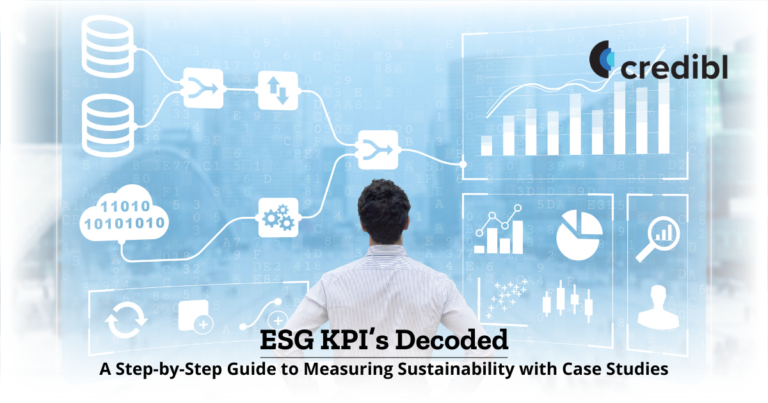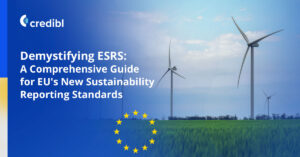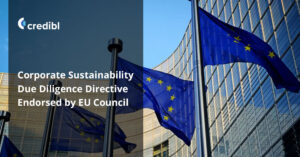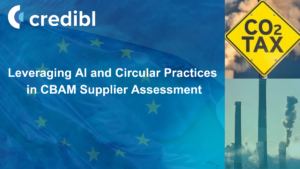Summary of the Blog
This blog provides a comprehensive guide on designing and measuring ESG KPIs for businesses. It begins with an overview of the latest trends in ESG metrics, emphasizing developments in green energy, executive remuneration, climate litigation, and political influences. The blog then outlines how businesses can design relevant and measurable ESG KPIs, focusing on key areas like community engagement, diversity, well-being, carbon footprint, and more. It also covers best practices in ESG KPI measurement, including setting clear goals, robust data collection, stakeholder engagement, integrated reporting, transparency, and external verification. Implementation strategies and challenges are discussed, supplemented with real-world case studies. Finally, the blog introduces Credibl ESG as a valuable resource for businesses seeking to excel in ESG metric design and measurement.
Introduction
In the realm of modern business, Environmental, Social, and Governance (ESG) metrics have become pivotal for companies keen on showcasing their commitment to sustainability and responsible practices. Understanding the nuances of these metrics is more than a compliance requirement; it’s a strategic imperative that influences a company’s long-term success and reputation. As we delve into this guide, we explore the latest trends and practical strategies for designing and measuring effective ESG Key Performance Indicators (KPIs), ensuring that your business not only aligns with global sustainability goals but also stands out in a competitive marketplace.
The Latest Trends in ESG Metrics and KPIs
The ESG landscape is continually evolving, reflecting the dynamic nature of the business, societal, and environmental challenges. 2023 has seen several key trends shaping the way companies approach ESG metrics:
- Green Energy Transition: Post the invasion of Ukraine, the focus on green energy has intensified. Countries and regions like the U.S., the EU, and the U.K. are competing in clean energy and climate-related projects, as seen in the U.S.’s Inflation Reduction Act and the EU’s Green Deal Industrial Plan.
- ESG Metrics in Executive Compensation: The integration of ESG metrics into executive remuneration is becoming increasingly common. A study by Willis Towers Watson found that over three-quarters of companies globally use ESG metrics in determining executive compensation. This trend underscores the shift from considering ESG as a ‘nice to have’ to a business necessity.
- Climate Litigation and Greenwashing: Legal challenges around environmental issues are on the rise, signifying an increased accountability for ESG claims. Regulatory bodies are implementing measures to combat greenwashing, exemplified by the European Commission’s criteria targeting misleading environmental claims.
- Political Impact on ESG in the U.S.: In the U.S., ESG efforts are becoming highly politicized, especially with the upcoming 2024 elections. This is evident from the introduction of approximately 100 anti-ESG bills in state legislatures, covering a broad spectrum of issues from investment decisions to diversity and inclusion efforts.
These trends highlight the increasing complexity and importance of ESG metrics in the current business climate, underscoring the need for companies to stay informed and adapt their strategies accordingly.
Designing ESG KPIs for Your Business
Designing ESG KPIs is a critical step for businesses aiming to align their operations with sustainable and responsible practices. Here are some key considerations and metrics to focus on in 2023:
- Community Engagement: Businesses are increasingly expected to measure and improve their relationships with local communities. Activities like sponsoring local events and skill donations can enhance reputation, employer branding, and staff retention.
- Employee Diversity and Wellbeing: Diversity and well-being are crucial social KPIs. Metrics should encompass diversity training and HR strategies, along with employee safety and pay equality. In 2023, the focus on pay equality as a part of employee wellbeing is particularly pronounced.
- Carbon Footprint and Waste Management: Tracking carbon emissions and waste management practices is essential. With increasing public scrutiny and mandatory reporting requirements, companies are encouraged to adopt innovative approaches for efficient waste management and carbon labeling.
- Total Energy Consumption: As mandatory reporting on energy consumption becomes more prevalent, companies need to monitor their energy use meticulously, considering the impact of supply chain choices on their overall energy consumption.
Incorporating these KPIs into your business strategy not only aligns with global sustainability trends but also enhances your company’s competitive edge. The next sections of this guide will delve into best practices for measuring these KPIs and effectively implementing them in your business strategy.
Best Practices in ESG KPI Measurement
As businesses increasingly recognize the importance of ESG metrics in their operations, establishing best practices for ESG KPI (Key Performance Indicator) measurement becomes paramount. Here are the key strategies to consider in 2023:
- Setting Clear Goals and Targets: The foundation of effective ESG KPI measurement lies in setting clear, well-defined goals and targets. These objectives should be quantifiable and tied to specific actions within the organization. Benchmarking against industry peers is crucial to set realistic expectations and stay competitive. The development of a comprehensive action plan, including short, medium, and long-term goals, is necessary to drive meaningful change.
- Robust Data Collection and Measurement: Reliable data collection and accurate measurement of ESG metrics are essential, especially as more investors seek companies aligned with their values. Businesses should adopt a holistic approach to data collection, considering all relevant factors, such as environmental practices and community health. Third-party sources can be instrumental in providing deeper insights and enhancing the reliability of the analysis. Clear definition and selection of appropriate benchmarks are vital for effectively measuring the impact of various programs.
- Stakeholder Engagement and Materiality Assessment: Engaging with stakeholders and conducting thorough materiality assessments are critical for identifying key issues and priorities. These assessments help in understanding the diverse sustainability issues an organization faces and in prioritizing initiatives that drive significant change. Understanding internal priorities from the perspective of external stakeholders allows businesses to consider the long-term societal implications of their decisions.
- Integrated Reporting Approach: An integrated reporting approach, combining financial and non-financial data, offers a holistic view of an organization’s performance. This method includes key performance indicators related to corporate values, such as responsibility towards customers, employees, and stakeholders. Integrated reports provide transparency and help in allocating resources effectively toward long-term success, showcasing a commitment to ethical practices and sustainability goals.
- Enhanced Disclosure and Transparency: Timely disclosure of information about progress and challenges to stakeholders is crucial. Creating dedicated communication channels on company websites and publicly reporting progress on set goals enhances transparency. Encouraging two-way dialogue between organizations and stakeholders, through feedback avenues, promotes accountability and builds trust, leading to improved financial performance.
- External Assurance and Verification: This practice, based on frameworks like COSO’s 2013 Internal Control-Integrated Framework, provides credibility and reliability in reporting. External assurance involves a comprehensive review of data fidelity, communication processes, and risk assessment techniques throughout the organization. This approach is crucial for companies to accurately assess their impact on society, the environment, and economic development.
Implementing ESG KPIs Effectively
Implementing ESG KPIs requires a strategic approach that integrates these metrics into the core business processes. Here are some effective strategies and considerations:
- Integrate ESG into Business Strategy: Ensure that ESG KPIs are not siloed but integrated into the broader business strategy. This integration helps align ESG initiatives with business goals, making them more impactful and easier to track.
- Employee Engagement and Training: Educate and engage employees at all levels about the importance of ESG metrics. Training programs and awareness campaigns can help embed ESG values into the company culture.
- Leverage Technology for Data Management: Utilize advanced data management tools and technologies to track, analyze, and report ESG metrics efficiently. This technological integration aids in handling large datasets and provides real-time insights for better decision-making.
- Regular Review and Adaptation: ESG metrics should not be static. Regularly review and adapt these KPIs to reflect changing market conditions, regulatory requirements, and stakeholder expectations. This flexibility ensures that the company remains responsive and relevant in its ESG efforts.
- Collaboration and Partnership: Collaborate with external stakeholders, including NGOs, industry groups, and regulatory bodies, to gain insights and align ESG goals with global standards. Partnerships can also provide access to resources and expertise that enhance ESG performance.
- Transparency and Accountability: Maintain transparency in ESG reporting and be accountable for the outcomes. Transparent reporting builds trust among stakeholders and helps identify areas for improvement.
By following these strategies and best practices, businesses can effectively implement ESG KPIs, making a tangible impact on sustainability while enhancing their competitive edge in the market.
Case Studies: Successful ESG KPI Implementation
Exploring real-world examples offers valuable insights into the effective implementation of ESG KPIs. Here are some notable case studies from 2023:
- Parnassus Investments and Wells Fargo & Co.: This case highlights the efforts of Parnassus Investments’ CEO, Ben Allen, in investing in Wells Fargo, balancing the financial interests of investors with ESG values. The strategic focus was on advancing both the financial welfare of the firm’s investors and the ESG principles held by the firm and its stakeholders. (Read here)
- Engine No. 1: A pioneering ESG-focused ETF by Engine No. 1, challenging traditional fund-industry assumptions. This initiative successfully combined active ownership with satisfying market needs, representing a novel approach to proxy fights and ESG integration. (Learn more)
- Alliance Bernstein Global ESG Improvers Strategy: Managed by Michelle Dunstan and Jeremy Taylor, this strategy exemplifies balancing investments in sectors like oil and ethanol production with ESG improvement objectives, showcasing a dual mandate of financial returns and ESG performance enhancement. (Read here)
- Newmont’s Ahafo Mine: The case of Newmont’s Ahafo Mine in Ghana emphasizes the strategic value of calculating the net present value of sustainability initiatives, showcasing how ESG can be integrated into core business valuation. (Learn more)
- Choppies in Botswana and Sub-Saharan Africa: Under CEO Ramachandran Ottapathu, Choppies’ retail operations in Botswana and Sub-Saharan Africa exemplify the impact of corporate operations on regional economies and communities, highlighting the social component of ESG. (Read here)
- Minas-Rio Project by Anglo American: This case study focuses on the design and implementation of an Integrated Project Management System at Minas-Rio, led by CEO Paulo Castellari. It underscores the importance of integrating ESG goals into project management and operational strategies. (Learn more)
- Glenmede Investment Firm: Glenmede’s approach, under Amy Wilson’s direction, to ESG investing demonstrates the integration of ESG considerations into investment strategies, ensuring credibility and buy-in from analysts and clients. (Read here)
- Abraaj Group and K-Electric: This study explores the Abraaj Group’s strategy for transforming K-Electric into a sustainable, growth-oriented utility. The focus was on integrating ESG policies into the company’s turnaround strategy. (Learn more)
Credibl ESG: Your Partner in ESG Measurement
In conclusion, as businesses navigate the complexities of ESG metrics and KPIs, having a knowledgeable and reliable partner is invaluable. Credibl ESG stands out as a resourceful ally in this journey. Offering expertise in ESG metric design and measurement, Credibl ESG provides the tools and insights necessary for businesses to integrate and benefit from ESG practices successfully. Whether it’s setting up robust KPIs, aligning them with global sustainability trends, or ensuring compliance and best practices, Credibl ESG’s services can be a game-changer for businesses committed to sustainable and responsible practices.
The examples and case studies discussed in this blog demonstrate that successful ESG implementation is not just a theoretical concept but a practical reality. With the right approach, tools, and partnerships, businesses can make a significant impact on sustainability while also achieving their commercial objectives. The evolving landscape of ESG metrics requires continuous learning and adaptation, and Credibl ESG can be an invaluable partner in this ongoing journey.







